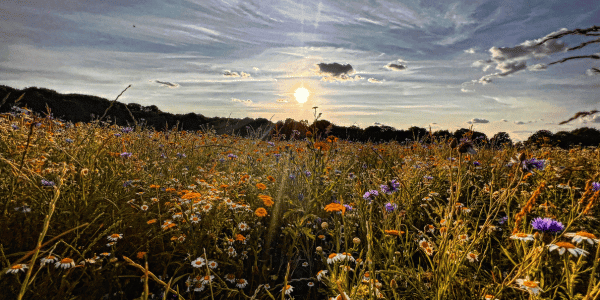Discover the Science, Secrets & Superstitions of the Summer Solstice

It’s not officially summer until the summer solstice strikes—or is it? And what is the summer solstice, exactly? Read on as we unlock the summer solstice meaning and the science, secrets, and superstitions of this historic day.
Understanding the Summer Solstice
The summer solstice is known as the longest day of the year for those living in the Northern Hemisphere. The Northern Hemisphere includes North America, Europe, and parts of Asia, Africa, and South America. For those in the Southern Hemisphere, think Antarctica, Australia, and most of South America, it’s the shortest day of the year. In the June solstice, the North Pole experiences 24 hours of sunlight, whereas the South Pole experiences 24 hours of darkness.
What Happens During the Summer Solstice?
As Earth slowly tilts along its axis, it also orbits the sun. This tilt permits different parts of the planet to get more or less sunlight during various times of the year. In June, the North Pole is tilted most directly toward the sun, and the Northern Hemisphere gets more sunlight.
On the day of the June solstice, the sun is at its highest point in the sky, allowing those in the Northern Hemisphere to get the most hours of sunlight they’ll see all year. It feels like the sun enjoys hanging out, forgetting its duties for the day. Hence the term solstice, or “sun standing still” in Latin.
Celestial Read: “Star Tracker: 5 Constellations Anyone Can Spot”
When is the Summer Solstice 2025?
Because the planet is in motion, the summer solstice isn’t on the same day every year. The June solstice can happen on June 20, 21, or 22. Summer solstice 2025 is set for Friday, June 20, 2025, at 10:42 EDT. However, the time can vary depending on your time zone.
History of the Summer Solstice: Summer Solstice Folklore and Myths
While the solstice marks the first day of summer for many people, it’s celebrated as midsummer for several others. The high point of summer, midsummer has been recognized since the New Stone Age. It’s believed that Neolithic stone circles were built to align with the movement of the sun at the solstices. Sacred places that were highly symbolic, people would gather at the stone monuments for summer solstice rituals and ceremonies.
Some other prominent symbols of solstice folklore include:
Ghosts and fairies. Many believe the barriers between the spiritual world and the living are retracted by the solstice, allowing ghosts and fairies alike to interact with humans, granting wishes or causing chaos as they see fit.
Bonfires. Honoring the sun and its power, bonfires are lit to ward off evil spirits and entice a good harvest.
St. John’s Day. A Christian holiday that celebrates the birth of John the Baptist, St. John’s Day coincides with many midsummer festivities. It has traditionally been recognized with baptisms, bonfires, and other events.
Nile River. In Ancient Egypt, the rising of the Nile River overlapped with the summer solstice. A magical occasion, Ancient Egyptians prayed to the sun god, Amun-Ra, the creator of life and ruler of the sun and sky, for nourishment and fertility.
Plants and herbs. St. John’s Wort is believed to protect you from evil spirits and has medicinal purposes. Lavender helps attract elves and fairies, and chamomile is used in ceremonial bonfires.
Oak. The oak tree has long been associated with midsummer celebrations. As the king of the forest, it’s thought to provide a doorway to the mythical world.
Summer Solstice Traditions: How the World Recognizes the Summer Solstice
People all over the globe celebrate this celestial event following summer solstice rituals, traditions, and customs. One of the most thrilling ways to honor the day is to visit one of the ancient stone structures built to align with the sun at the solstice. Surprisingly, there are quite a few that are still in existence today.
Here are some of the most famous places to visit on the summer solstice:
Stonehenge. Wiltshire, UK. The sun rises behind the Heel Stone, and its first rays shine into the monument's center.
Grange Stone Circle. Lough Gur, Ireland. The entrance of the circle is aligned with the rising sun.
Hovenweep National Monument. Utah, U.S. At sunrise, a light pierces through a small opening, shining on a specific place on the back wall. It’s believed to have been used to trace out a solar calendar.
Casa Grande Ruins National Monument. Arizona, U.S. The setting sun aligns with a small round hole in an upper western-facing wall.
Chichen Itza, Mexico. The setting sun casts a shadow on the south and west sides, visually splitting the monument in half.
How to Celebrate Summer Solstice
You don’t have to travel across the world to experience summer solstice celebrations. With summer solstice traditions and history in mind, you can recognize the day by doing several activities right here at home. Some ways to celebrate the summer solstice and family activities for the summer solstice include:
- Building a small bonfire in your backyard
- Inviting friends and family over for a backyard BBQ
- Watching the sun rise or set
- Going on a nature scavenger hunt
- Gathering and planting herbs
- Creating a sun catcher or sundial
- Practicing outdoor yoga or meditation
- Painting a sunny scene
- Dancing or exercising outdoors
Before you fire up the coals, read “BBQ Showdown” to find the right grill for you.
Happy Summer Solstice! 7 Fun Activities to Welcome Summer
Whether it marks the beginning or middle of summer, celebrating the season is what the summer solstice is all about. Ideal for outdoor fun and adventure, it’s the perfect time to make some memories. Read “7 Things to Add to Your Summer Bucket List” to learn seven exciting things to do this season.
